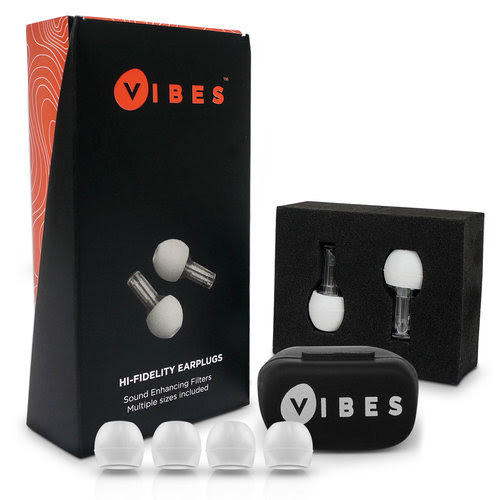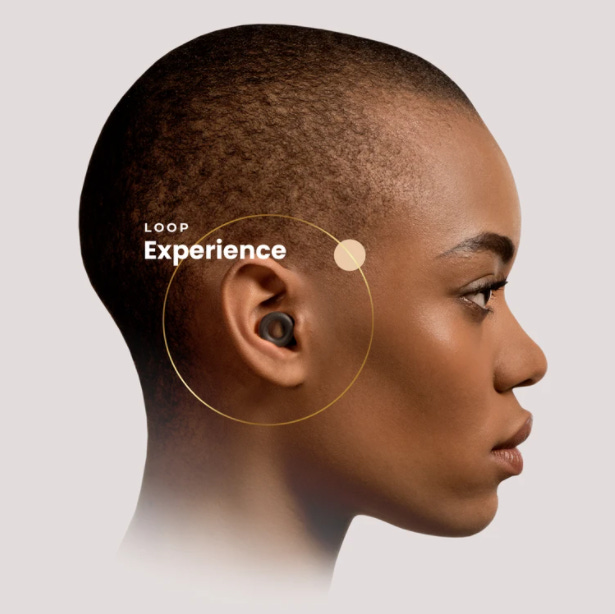Vibes: Filtering Sound for Those Who Can't
How a high-fidelity earplug is changing the way we're listening to the world and those in it.
Accessible is a weekly newsletter covering all things assistive tech. Once per month, we release a public database of products based on reader requests. Accessible does not accept funding from any companies covered in order to showcase the opinions of product users faithfully.
If you would like to subscribe, click the button below.
The world is loud.
Zero decibels (dBA) is the softest sound a person with average hearing is able to pick up. 85 dBA is the loudest sound we are able to sustain for an 8-hour period of time without sustaining hearing damage.
The loudest cities in the world average at least 100 dBA on a daily basis. One car horn creates a 110 dBA, an ambulance going by is another 120 dBA, and simply the existence of traffic adds at least 85 dBA to the mix.
What if you try to get away from the hustle and bustle and stay inside? Not much changes.
The average coffee shop is 73 dBA. Health and fitness clubs get up to 120 dBA, and movie theaters average 118 dBA. Each person having a conversation contributes 60 dBA to the noise pollution wherever you go, plus any activity they’re engaging in. A refrigerator simply turned on is 50 dBA. A washing machine adds 75 dBA. Every time your phone rings: 80 dBA. Your baby cries? 110 dBA.
The noise does not end.
And all of this noise, regardless of its decibels, is flagged with the same importance to most people with an auditory processing disorder, Autism, and even some with ADHD. There is no discretion between the barista making coffee 15-feet away, the customer typing on a keyboard nearby, or the high-pitched hum of a charger in the wall.
The listener needs to manually sort through each of these inputs, attempt to ignore the non-important ones (although they may be highly irritating), and engage in the conversation at hand. Sifting through every sound in a room to find the words of the person speaking to you is exhausting, and just one small piece of what leads to sensory overload.
On top of the world already being a noisy place, COVID-19 has added to the stress. For over a year and a half, most of us stayed in our homes where the noises were somewhat quieter (unless you have one of those 110 dBA babies). It’s a hot topic in the Neurodivergent community right now about how getting back out in the world has been more challenging than expected due to noise. So where do we go from here?
Traditionally there have been three ways to cut out the noise:
Foam earplugs
Noise-canceling headphones
So if there are already solutions, what is the problem? Many. While these are still good options for some circumstances, many of the available solutions are lacking in the following ways:
Lack of discreteness.
Don’t allow for active engagement in conversations with others.
Only block high-frequency sounds.
Attempt to block all sounds, rather than filter for specific sounds.
Vibes, an earplug company, has solutions for all of the above problems - even if they didn’t realize it at first.
The story of Vibes
Originally designed for concerts, Vibes are earplugs positively impacting how people with Autism and other auditory sensitivities are interacting with the world in a way that was unexpected. Here’s a bit about them:
Discrete (clear plastic, so when worn it is not noticeable).
Allow for active engagement in conversations with others.
Filter low and high-frequency noises (most earplugs only reduce high-frequency noises).
High-fidelity filtering earplugs (reproduce similar noises at a lower sound).
Reduce background noises.
The tech
Vibes earplugs have sound tubes embedded in each earplug. The tubes reduce all sounds but filter them down to a manageable level while maintaining rich sound quality since they were originally designed for concerts. Both low-frequency and high-frequency sounds are filtered, which is unheard of in earplugs. Traditional earplugs attempt to stop noise from entering the ear altogether and only block high-frequency sounds.
This fresh approach to earplug technology has been a game-changer for the Neurodivergent community. Users can wear Vibes throughout the day and keep them in during conversations, all the while reducing the noise in their environment by an average of 22 dB or a 15 Noise Reduction Rating (the highest NRR available is a 33).
In short: Vibes actually succeeded when it comes to blocking out the right noises rather than all noises.
Each pair of Vibes costs $23.99, including a case and three different sizes of silicone earbuds.
Founding story
I don’t normally go into the founding story of companies, but this is a fun one. Vibes was founded in 2016 and is based in Minneapolis, MN (my hometown).
Just a few months into their founding, Vibes was featured on SharkTank. The investors on the show offered a $100,000 investment for 35% of their shares and a $2 royalty fee per pair of earplugs sold was offered — ouch.
Founder Jackson Mann turned down the investment and went on to bootstrap his company, believing so much in his mission that he worked out of his van for almost a year.
It turns out that it was the right bet to make.
In 2018, Vibes had already hit $2 million in sales. My favorite part of their founding story is instead of paying a $2 royalty fee to the potential investor, the company now donates to Hear the World Foundation for every pair of Vibes purchased.
That’s a proud Minnesota stick-it-to-the-man moment.
In production: How I use mine
Vibes are an essential part of my daily life. I wear them while shopping, out for coffee, biking, at restaurants/bars, and to be honest most times I’m out in public. I use them so often a large chunk of my family and friends have adopted them too.
The only downside I have to say about them is I’ve purchased at least 5 new pairs this year already due to losing them, although that seems to be more of a me problem than a Vibes problem.
Thankfully they only cost a little over $20, so it’s not a huge deal. Being able to spend more time out for coffee, riding my bike, going shopping, and actively engaging in conversations is well worth the cost of 5 pairs of Vibes, which to be honest are probably all under a particular part of my driver’s seat I can’t reach :)
Tips & Tricks
I’ve had a lot of people ask me upon finding out how often I use my Vibes for some tips. Here are some friendly tips and tricks from one user to another:
Purchase a keychain carrying case. When you order a pair of Vibes it comes with a standard case that is easy to lose. Now I have a case that is hooked to my keys so it comes everywhere with me! To my knowledge, they don’t sell this case on their site, but it is on Amazon. Any case that clips to your keys will do.
Put them back immediately after use. Get in this habit and stay in it. These little guys are easy to lose, so put them in your carrying case immediately after taking them out of your ears.
Keep a backup pair. If you use them every day, you will lose a plug or two. Don’t worry about it! I keep a backup pair so when I lose mine I have a pair to wear while my new backups are in the mail.
Practice talking in them. When I started wearing mine people noted I was speaking much quieter than usual. Get a sense of your voice when wearing them and have a conversation with a supportive friend or family member before going out if possible.
Give it a try. Several people I know, particularly kids, didn’t like the feeling of the Vibes in their ears. They did, however, like the sound filtering for shopping and other noisy places with a bit of practice wearing them. You likely won’t hear a difference unless you go into a noisy environment. Give it a try, but if you have and don’t like it that’s okay! Wearing earplugs isn’t for everyone :)

Competitors
Vibes has a decent amount of competitors if you’re looking at the traditional earplug or noise cancellation market. When it comes to high fidelity and low profile earplugs though, there aren’t many competitors.
Loop
Loop, a seed-stage startup, has created a similar product. Loop has received a total of €1.3M in funding over 5 rounds, with their latest round announced on Jul 2, 2020.
Although Loop has received more funding, arguably they have not perfected their product to the level that Vibes has yet.
I found the Loops difficult to place and keep in my ears for long periods of time and they did not filter conversations as clearly. I was more distracted by adjusting the loops than I was by the other sounds going on around me. I’m also not as big of a fan of loops due to them being much more visible than Vibes. Another user I spoke with had a similar experience, although we don’t speak for all Loop users. They have a 4.5 star rating on Amazon and almost 5,000 reviews.
Loops run from $25 to $35 per pair.
NoNoise
NoNoise is the first company to create a noise filtering device from ceramic. While the piece touching the user’s ear is silicone, they claim the ceramic portion of the noise filter is excellent at filtering background noise. I have not tried these as all of the options are bright silicone colors, and I’m not a huge fan of the shape.
NoNoise runs from about $23-$27 per pair and is available for purchase from the UK at this time.
Eargasm
Eargasm does win the award for the most uncomfortable brand name. But despite the (very) unfortunate name, they do have an extensive portfolio of high-quality earplugs.
Their traditional high fidelity earplugs start at $39.99 and go all the way up to $249.00. One positive of Eargasm is they have replaceable shells and replaceable filters, plus cleaning components. My Vibes have never broken so I haven’t seen a need to replace any parts, but those of you that are able to keep them safe for years on end may find this valuable.
They aren’t as simple, comfortable, cost-efficient, or discrete — much like its name. But these earplugs are a great option if Vibes do not work for you. Eargasm (ugh) also makes custom pairs for a higher price.
Takeaway
Vibes is making the world a more accessible place every day for those of us with auditory sensitivities. This product is making it possible to engage in meaningful conversations, enjoy community events, and just get coffee with friends without the stigma or muffling of traditional earplugs and headphones.
They’re creating a product that is discrete, filters/reduces sounds rather than muffles it, and doing it at an affordable price for users. And on top of that, instead of paying $2 per pair of Vibes sold to a potential investor, they’re donating from every pair sold to a great cause.
If you can’t tell already, I’m a huge fan of Vibes. I’ll be a lifelong user unless someone comes along and is able to implant similar tech straight into my ear.







